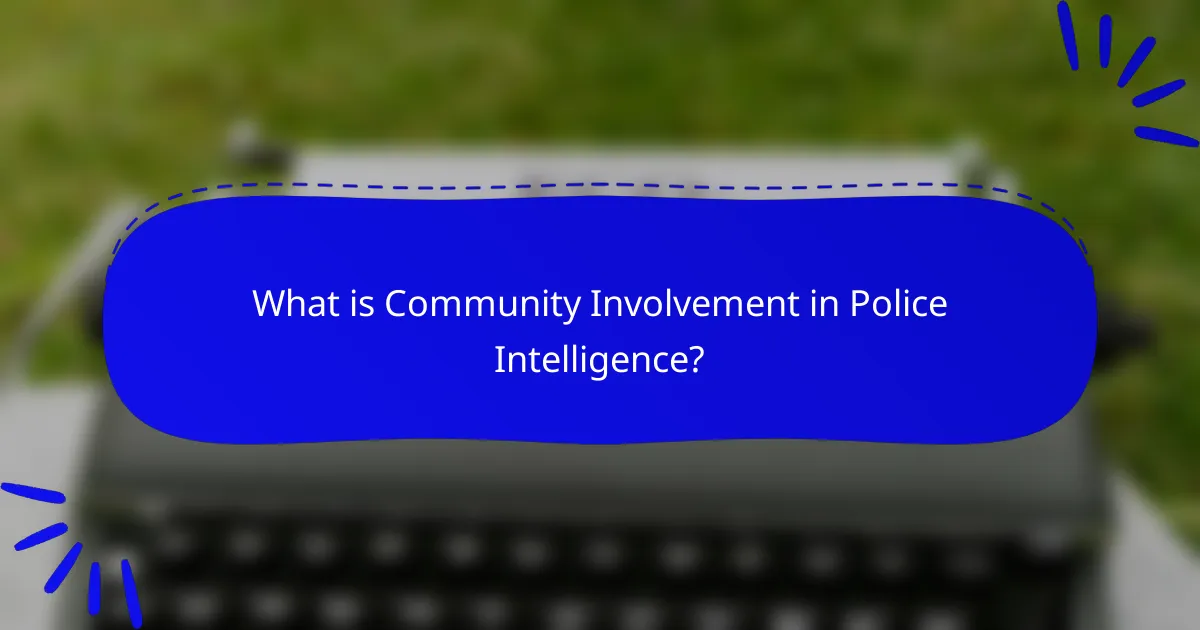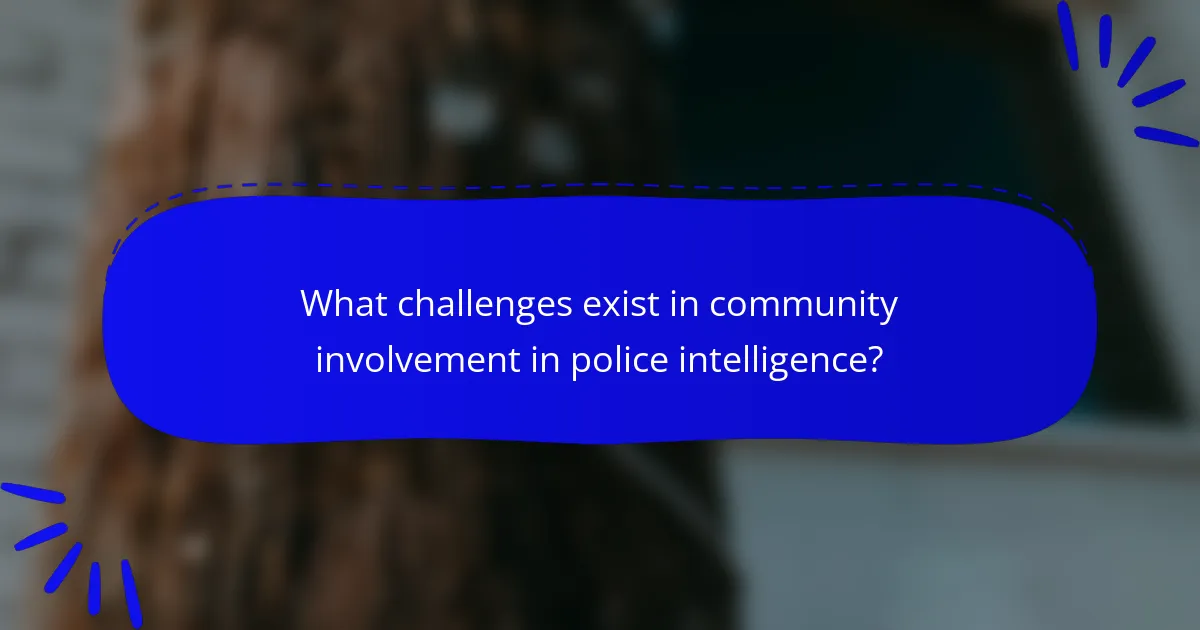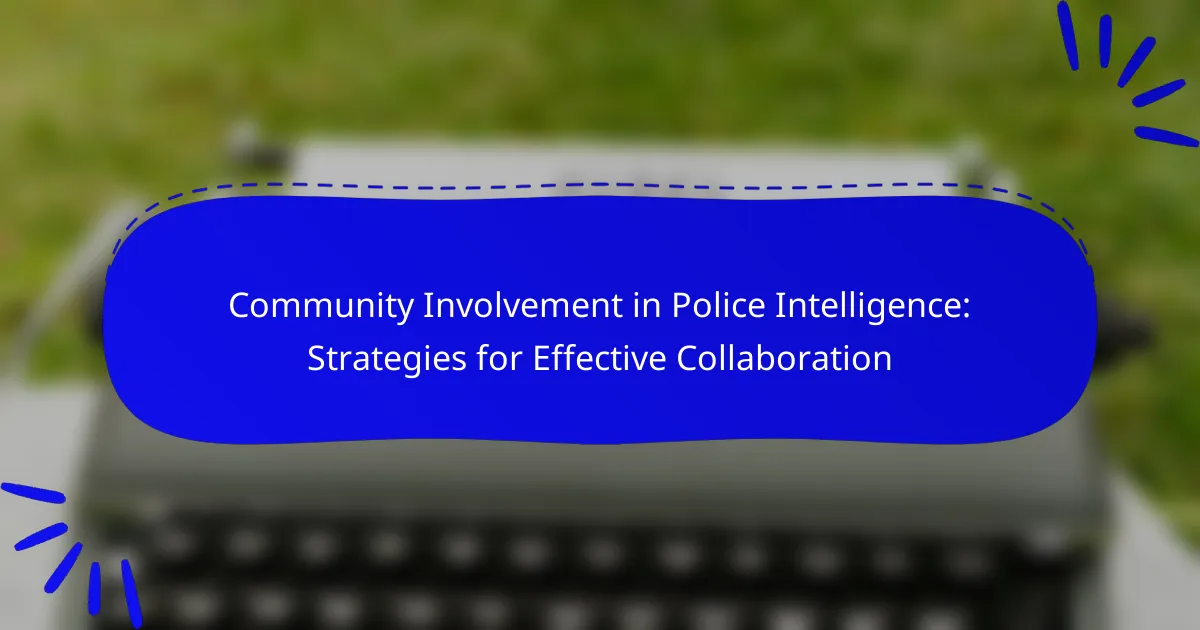
What is Community Involvement in Police Intelligence?
Community involvement in police intelligence refers to the active participation of community members in sharing information and collaborating with law enforcement. This involvement enhances the effectiveness of policing by fostering trust and open communication between the community and police. It allows for the gathering of local insights that can aid in crime prevention and resolution. Research indicates that community-police partnerships can lead to a reduction in crime rates and improved public safety. For example, programs like neighborhood watch initiatives exemplify successful community involvement in police intelligence. Such collaboration creates a shared responsibility for safety and encourages community members to report suspicious activities.
How does community involvement enhance police intelligence efforts?
Community involvement enhances police intelligence efforts by fostering trust and collaboration between law enforcement and the public. Engaged communities are more likely to share crucial information about criminal activities. This information can lead to timely interventions and prevent further crimes. Studies show that neighborhoods with active community programs report higher crime-solving rates. For example, the National Institute of Justice found that community policing initiatives improve communication and cooperation. Enhanced relationships lead to better data collection and analysis. Additionally, community members often provide unique insights that law enforcement may overlook. Overall, community involvement is vital for effective policing and intelligence gathering.
What specific roles do community members play in police intelligence?
Community members play crucial roles in police intelligence by providing information, fostering trust, and enhancing collaboration. They serve as eyes and ears in their neighborhoods, reporting suspicious activities. This grassroots intelligence can lead to timely police interventions. Community members also participate in neighborhood watch programs, which increase vigilance. Their involvement helps build relationships with law enforcement, promoting transparency. Additionally, community forums allow citizens to share concerns and insights. Engaging with community members can lead to better understanding of local issues. Research shows that community-police partnerships improve crime-solving rates and public safety.
How can community feedback improve police strategies?
Community feedback can significantly enhance police strategies by fostering trust and improving communication. Engaging with the community allows law enforcement to understand local concerns and priorities. This feedback can lead to more effective crime prevention strategies tailored to specific neighborhoods. Studies show that police departments implementing community feedback have seen reductions in crime rates. For instance, a 2018 study by the Police Foundation found that community-oriented policing initiatives increased public satisfaction with police services. Furthermore, feedback can help identify training needs for officers, ensuring they are better prepared to serve diverse populations. Ultimately, community input creates a collaborative environment that enhances public safety and accountability.
Why is collaboration between police and the community essential?
Collaboration between police and the community is essential for enhancing public safety and trust. This partnership fosters open communication and understanding between law enforcement and residents. It allows police to gain valuable insights into community concerns and crime trends. Community members can provide information that helps solve crimes and prevent future incidents. Research shows that neighborhoods with strong police-community ties experience lower crime rates. A study by the National Institute of Justice found that community policing strategies improve perceptions of safety. This collaboration also promotes accountability and transparency within law enforcement. Overall, effective collaboration leads to safer, more engaged communities.
What are the historical contexts of police-community collaboration?
Police-community collaboration has evolved significantly over time. Historically, policing in the early 20th century focused on crime control with little community engagement. The civil rights movement in the 1960s highlighted the need for better relationships between police and communities, particularly marginalized groups. The introduction of community policing in the 1980s emphasized proactive partnerships and problem-solving strategies. This approach aimed to address community concerns and improve public trust. Research indicates that effective collaboration can reduce crime rates and enhance community safety. Studies have shown that when communities are involved in policing, it leads to more effective law enforcement outcomes.
How does collaboration affect public trust in law enforcement?
Collaboration positively impacts public trust in law enforcement. Joint efforts between police and community members foster transparency and accountability. When law enforcement engages with the community, it demonstrates a commitment to addressing public concerns. This partnership often leads to improved communication and understanding. Research shows that communities involved in policing initiatives report higher trust levels. For example, a study by the Bureau of Justice Statistics indicated that community policing strategies enhance perceptions of police legitimacy. Effective collaboration also results in shared problem-solving, which builds stronger relationships. Ultimately, these factors contribute to a more trusting and cooperative environment between law enforcement and the public.

What strategies can be implemented for effective collaboration?
Effective collaboration can be achieved through clear communication, mutual respect, and shared goals. Establishing regular communication channels enhances information flow. Utilizing collaborative technologies fosters real-time interaction. Setting common objectives aligns efforts among stakeholders. Encouraging feedback creates an inclusive environment. Building trust strengthens relationships and encourages openness. Training sessions can enhance skills and understanding of roles. Engaging community members ensures diverse perspectives are considered.
How can police departments foster community engagement?
Police departments can foster community engagement through proactive outreach initiatives. They can organize community meetings to address local concerns. These meetings allow residents to voice their opinions and build trust. Police can also establish neighborhood watch programs to encourage community participation. Collaborating with local organizations enhances outreach efforts. Additionally, using social media platforms helps police departments communicate effectively. Regular updates and transparency in operations increase public confidence. Programs that involve youth, such as school resource officers, can cultivate positive relationships. Research shows that community policing strategies lead to reduced crime rates and improved community relations.
What outreach programs are most effective in building relationships?
Community outreach programs that effectively build relationships include neighborhood watch programs, community policing initiatives, and youth engagement activities. Neighborhood watch programs foster trust between law enforcement and residents. They encourage community members to collaborate on safety initiatives. Community policing initiatives focus on building partnerships between police and community members. They emphasize proactive problem-solving and open communication. Youth engagement activities, such as mentorship programs, create positive interactions between police and young people. These programs help to break down barriers and build mutual respect. Research shows that community involvement enhances public safety and trust in law enforcement. Studies indicate that neighborhoods with active outreach programs report lower crime rates and improved community relations.
How can technology facilitate collaboration between police and the community?
Technology facilitates collaboration between police and the community by enhancing communication and information sharing. Digital platforms allow for real-time reporting of incidents by citizens. This encourages community engagement and responsiveness. Social media tools enable police departments to disseminate information quickly. Community members can provide tips and feedback directly to law enforcement. Mobile applications offer features for reporting crimes anonymously. Data analytics can identify crime patterns and community concerns. These technological tools foster trust and transparency between police and residents. Studies show that communities with effective technology use report higher satisfaction with police services.
What training is necessary for police officers to engage with the community?
Police officers require community engagement training to build trust and foster collaboration. This training typically includes communication skills, cultural competency, and conflict resolution. Officers learn to actively listen and respond to community concerns. They also study the diverse backgrounds of the populations they serve. Understanding local issues and resources is emphasized. Role-playing scenarios often simulate real-life interactions. Training may involve partnerships with community organizations. Research shows that effective community engagement reduces crime and enhances public safety.
What skills should officers develop for effective communication?
Officers should develop active listening, clarity in speech, and empathy for effective communication. Active listening enables officers to understand community concerns fully. Clarity in speech ensures that messages are conveyed accurately. Empathy helps officers connect with individuals on a personal level. Additionally, cultural competence is essential for understanding diverse community backgrounds. Non-verbal communication skills also play a crucial role in conveying trust and respect. These skills enhance community relations and foster collaboration. Research shows that effective communication significantly improves community trust in law enforcement.
How can cultural competency training benefit police-community relations?
Cultural competency training can significantly enhance police-community relations. This training equips officers with the skills to understand and respect diverse cultural backgrounds. Improved understanding fosters trust between police and community members. Trust leads to better communication and cooperation. Enhanced communication can result in more effective policing. Studies show that communities with culturally competent police experience lower crime rates. For example, a report from the National Institute of Justice highlights improved community satisfaction in areas with such training. Overall, cultural competency training is essential for building stronger police-community partnerships.

What challenges exist in community involvement in police intelligence?
Challenges in community involvement in police intelligence include mistrust between the community and law enforcement. This mistrust often stems from historical injustices and perceived biases in policing. Additionally, there is a lack of awareness among community members regarding the role of police intelligence. Many citizens may not understand how their input can contribute to public safety. Communication barriers also exist, as police may not effectively convey their needs for information or collaboration. Furthermore, concerns about privacy and confidentiality can deter individuals from sharing information. There is also the potential for community members to fear retaliation for providing intelligence. Lastly, limited resources and training for both police and community members can hinder effective collaboration. These challenges complicate the process of fostering a cooperative relationship necessary for successful community involvement in police intelligence.
How can mistrust between police and communities be addressed?
Building trust between police and communities requires consistent engagement and transparency. Police departments should implement community policing strategies. These strategies involve officers actively participating in community events and discussions. Regular communication can help demystify police practices. Establishing advisory boards with community members fosters collaboration. Training officers in cultural competency improves understanding of community needs. Transparency in police operations, such as sharing data on crime and responses, enhances accountability. Research indicates that communities with engaged police see lower crime rates and increased satisfaction with law enforcement. For example, a study by the Police Foundation found that community engagement initiatives led to improved perceptions of police legitimacy.
What are common misconceptions about police work in communities?
Common misconceptions about police work in communities include the belief that police officers are primarily focused on making arrests. In reality, police work involves a wide range of activities aimed at community safety and engagement. Many people think that police only respond to crimes after they occur. However, proactive measures such as community policing are essential in preventing crime. Another misconception is that police officers have complete authority and can act independently without oversight. In fact, police actions are subject to regulations and community accountability. Additionally, some believe that police do not care about the communities they serve. Research indicates that many officers are deeply committed to building relationships and trust within their communities. Lastly, there is a notion that all police officers are the same, but individual officers have different backgrounds, experiences, and approaches to policing.
How can transparency help reduce community skepticism?
Transparency can significantly reduce community skepticism by fostering trust and accountability. When police departments openly share information about their practices, policies, and decision-making processes, it demystifies their operations. This openness allows community members to understand the rationale behind actions taken by law enforcement. Research shows that communities are more likely to support police initiatives when they feel informed and included in discussions. For example, a study by the National Institute of Justice found that transparency initiatives led to a 20% increase in public trust in police. By establishing clear communication channels, departments can address concerns and clarify misconceptions, further enhancing community relations.
What are the implications of insufficient community involvement?
Insufficient community involvement leads to a lack of trust between law enforcement and residents. This gap can result in reduced cooperation during investigations. Consequently, police may struggle to gather crucial intelligence. The absence of community input can also lead to misaligned policing priorities. Community safety concerns may remain unaddressed, increasing crime rates. Moreover, insufficient involvement can foster a sense of alienation among residents. This alienation can further diminish community engagement in public safety efforts. Ultimately, the effectiveness of police intelligence operations may be severely compromised.
How does a lack of collaboration affect crime rates?
A lack of collaboration can lead to increased crime rates. When community members and law enforcement do not work together, vital information often goes unshared. This lack of communication can hinder crime prevention efforts. Studies show that neighborhoods with strong community-police partnerships experience lower crime rates. For instance, a report by the Bureau of Justice Statistics found that community involvement significantly reduces violent crime. Additionally, without collaboration, police may miss critical insights that could help in solving cases. This gap can create a sense of insecurity among residents, further exacerbating crime issues. Overall, collaboration is essential for effective crime reduction strategies.
What are the potential consequences for community safety?
Potential consequences for community safety include increased crime rates and diminished trust in law enforcement. When community members feel unsafe, they may avoid reporting crimes. This can lead to a lack of vital information for police. Consequently, crime prevention efforts may weaken. Additionally, community tensions can rise if residents feel neglected. A breakdown in communication between police and the community can occur. This may result in heightened fears and social unrest. Effective collaboration can mitigate these risks, fostering a safer environment.
What best practices should be followed for successful collaboration?
Successful collaboration requires clear communication among all parties involved. Establishing regular meetings fosters transparency and updates on progress. Setting shared goals aligns the efforts of all participants. Defining roles and responsibilities clarifies expectations and accountability. Utilizing collaborative tools enhances coordination and information sharing. Encouraging feedback promotes continuous improvement and adaptation. Building trust through respect and understanding strengthens relationships. Celebrating successes together reinforces teamwork and motivation.
Community involvement in police intelligence refers to the active participation of local residents in sharing information and collaborating with law enforcement to enhance public safety. This article examines the significance of community-police partnerships, the roles community members play, and the impact of collaboration on trust and crime reduction. It also explores strategies for effective engagement, the importance of transparency, and the challenges faced in fostering community involvement. Key insights include the benefits of outreach programs, training for officers, and the use of technology to facilitate communication, ultimately highlighting best practices for successful collaboration in policing.
